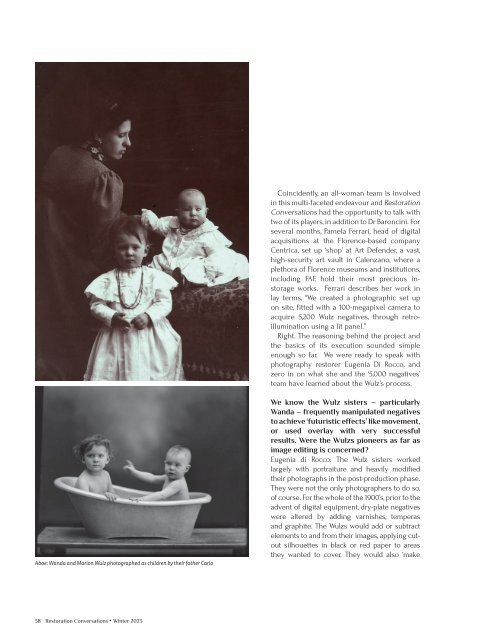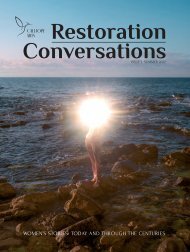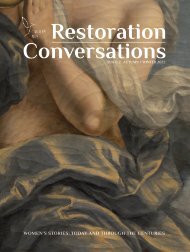Winter 2023
Restoration Conversations is a digital magazine spotlighting the achievements of women in history and today. We produce two issues a year: Spring/Summer and Fall/Winter
Restoration Conversations is a digital magazine spotlighting the achievements of women in history and today. We produce two issues a year: Spring/Summer and Fall/Winter
You also want an ePaper? Increase the reach of your titles
YUMPU automatically turns print PDFs into web optimized ePapers that Google loves.
Coincidently, an all-woman team is involved<br />
in this multi-faceted endeavour and Restoration<br />
Conversations had the opportunity to talk with<br />
two of its players, in addition to Dr Baroncini. For<br />
several months, Pamela Ferrari, head of digital<br />
acquisitions at the Florence-based company<br />
Centrica, set up ‘shop’ at Art Defender, a vast,<br />
high-security art vault in Calenzano, where a<br />
plethora of Florence museums and institutions,<br />
including FAF, hold their most precious instorage<br />
works. Ferrari describes her work in<br />
lay terms, “We created a photographic set up<br />
on site, fitted with a 100-megapixel camera to<br />
acquire 5,200 Wulz negatives, through retroillumination<br />
using a lit panel.”<br />
Right. The reasoning behind the project and<br />
the basics of its execution sounded simple<br />
enough so far. We were ready to speak with<br />
photography restorer Eugenia Di Rocco, and<br />
zero in on what she and the ‘5,000 negatives’<br />
team have learned about the Wulz’s process.<br />
Aboe: Wanda and Marion Wulz photographed as children by their father Carlo<br />
We know the Wulz sisters – particularly<br />
Wanda – frequently manipulated negatives<br />
to achieve ‘futuristic effects’ like movement,<br />
or used overlay with very successful<br />
results. Were the Wulzs pioneers as far as<br />
image editing is concerned?<br />
Eugenia di Rocco: The Wulz sisters worked<br />
largely with portraiture and heavily modified<br />
their photographs in the post-production phase.<br />
They were not the only photographers to do so,<br />
of course. For the whole of the 1900’s, prior to the<br />
advent of digital equipment, dry-plate negatives<br />
were altered by adding varnishes, temperas<br />
and graphite. The Wulzs would add or subtract<br />
elements to and from their images, applying cutout<br />
silhouettes in black or red paper to areas<br />
they wanted to cover. They would also ‘make<br />
38 Restoration Conversations • <strong>Winter</strong> <strong>2023</strong>





